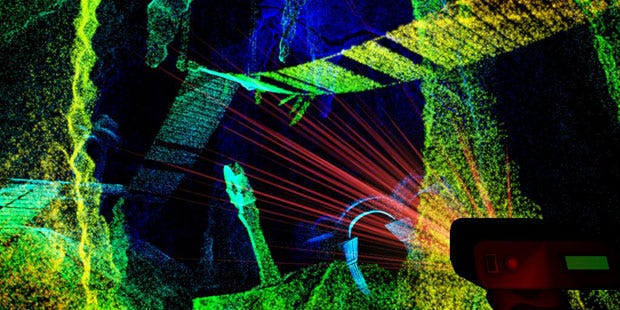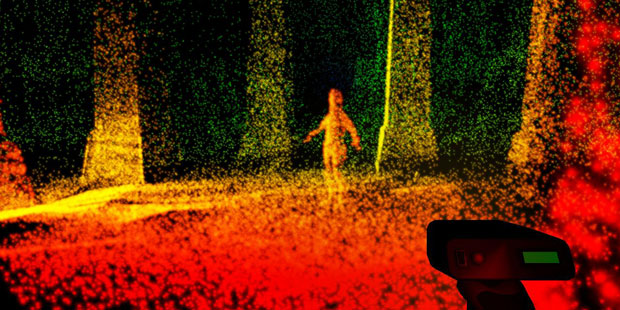Prison Architect's Chris Delay On Introversion's TWO New Prototypes
Prison Break
While at Rezzed the Prison Architect devs Introversion casually plonked not one but TWO new game prototypes onto the show floor – one a bomb defusal idea with echoes of the studio's erstwhile project, Subversion, and the other an exploratory mood piece where scanning a pitch black cave system gradually picks out shapes with a speckled spectrum.
Scanner Sombre is the latter and the weird and wonderful aesthetic is what drew me into the room in the first place. Introversion's lead designer, Chris Delay, was there, helping man the room and listening to reactions from the steady stream of players. We headed to one side to discuss the new projects and how they came into being – it turns out they were a kind of busman's holiday…
"We've been doing Prison Architect [official site] for five years and I've been doing it since October 2010, so we needed a bit of a break," says Delay. "Last year we took a month out and decided we were going to make some prototype games and so we did an update for Prison Architect that was just bug fixes and me, Leander [Hambley] and one other audio guy made these two prototypes in one month. It was really tight and fast and I had a clear idea of what we were going to do."
So they were made at the same time and from the same brain, but they're not otherwise connected. I played Scanner Sombre because I will always gravitate towards visual oddities in gaming but needed to scoot off before I got time in with Wrong Wire, instead having to settle for peering over the shoulders of others.
"The one you played is quite esoteric and quite weird," says Delay. "I said 'I've had this idea' in that I just basically love point cloud data like LIDAR data - they use it to scan cities and roads and things. I think it looks very inhuman and impersonal and strange but beautiful at the same time. If I combine that with being trapped in quite a claustrophobic cave network with no visible light that would be a very atmospheric environment."
He later links me to Radiohead's 2008 video for House Of Cards, explaining that the ideas for both games pre-date Prison Architect:
Let me tell you a bit more about my experience with Scanner Sombre before I go on with the chat.
You spawn in a cave with a fire burning in the middle. There's a scanner gun which you pick up before heading off down a pitch black tunnel. The scanner is kind of reminiscent of one of those handheld barcode scanners and shoots a cone of laser beams off into the darkness. When these beams hit a surface they leave a pinprick of colour so the more you use the scanner, the more concentrated the speckles become on a surface, creating a more and more detailed outline of the environment. You can control the size of the scanner aperture so when you get to a cavernous space you can widen the spray of laser beams and get a quick impression of the basic layout. If you need better information for more detailed exploration you concentrate the beam.
The trail you leave is colourful but the colour adds another layer of meaning, with the dots closest to you being bright red and moving through the spectrum to dark blue for the points furthest away. There's no real sense of solid space either, because although you can't pass through cave walls you can see all the previous particles you've left in the form of these ghostly blue tunnels, stretching back to the start area. Several human-shaped figures speckled into view at various points, frozen in time and when I dropped from one bridge to another an alarm started to sound.
The demo at Rezzed was actually a loop which wound through caves and across bridges before leading you to a steep drop back into the starting area. There was no explicit narrative, just hints of ideas which could feasibly be developed into something meatier, or left as mysteries. Where Prison Architect is a detailed floorplan, Scanner Sombre is closer to a sketch.
"It is one of those games that's derogatorily referred to as a walking simulator at times. I'd describe it as an exploratory experience. I don't see it being an enormous game like Prison Architect. I see it being like a one hour experience you play and you feel some things, hopefully," says Delay. "The combination of the visual lack of anything other than rainbow colours mixed with the audio is a strange feeling. I like the fact videogames can do that."
He adds, "If you were to plot every game genre in a 3d cube, this would be as far away as you could get from Prison Architect - the exact opposite. No simulation, no system layers, no three years of early access. We love Prison Architect - it's my very own Dwarf Fortress. I love it for that and it's been a dream project but we needed a break and Scanner Sombre is very much just us being creative and making something totally different to our other games."
Over the course of the expo Introversion were actually running a kind of voting system where you could drop a token into a box to say which of Scanner Sombre and Wrong Wire was the more interesting project. Scanner Sombre ended up winning, although not by too much, with 349 votes to Wrong Wire's 284.
"To me that means both games were good," says Delay. "There's not a lot in it. Scanner Sombre, people were attracted to quicker because it doesn't really look like anything else. Wrong Wire is more traditional Introversion fare. That's more system driven/simulation driven.
"You have these electrical devices which are bombs and they're simulated on the basic electronic level and you've got microchips running this code and you have to reverse engineer the bomb and defuse it. You have tools [that allow you to] read the microchips that are inside the circuitry, and read the code off it and try to figure out how it works. It's sort of like The Room crossed with Keep Talking And Nobody Explodes."
Keep Talking And Nobody Explodes is the game which I was leaning towards for comparison as I watched other people play.
"We love that game, it's a great game and they're both about bomb defusal so there's always going to be a comparison, but that game is about human-to-human contact; trying to get your mate to read the instructions while you try and explain what you're looking at. It's hilarious to play. Our game is more like a single-player puzzle game. The bombs that we're dealing with are large and more expansive devices.
"One of the levels is a suitcase bomb on an underground train. It's quite a complex device and a lot of people have been getting stuck on it at Rezzed. This is the first time we've ever shown these games so this is the first usability test as well so some of the people don't quite get some of the leaps they have to make. They're not thinking as dark as we do!"
Sidenote: I feel slightly strange at this particular point. I'm not usually put off by the presence of bombs in games – I mean, hi Counter-Strike, Keep Talking And Nobody Explodes, Monet And The Mystery Of The Orangerie Museum, Batman: Arkham Knight, Call of Duty… – but there is still something about the mention of bombs on the underground which, I guess as a Londoner, is weirdly too close to home. I'm not saying this to call out Introversion, just that it was an unexpected feeling to arise in the interview and I guess it made me think a little more about how and when games make me uncomfy personally rather than ideologically.
Delay goes on to talk about the relationship between Wrong Wire and the far older Introversion project, Subversion. The term you'd probably use is "spiritual successor" nowadays but that makes the game seem more concrete than a prototype being playtested for the first time by the outside world.
"We had a project called Subversion before Prison Architect," says Delay. "It was kind of a disaster. We spent years working on the simulation and tech and it was all about wiring and high tech locks and high tech heists. Wrong Wire is mechanically very similar in that you're slowly unlocking a device, you're unlocking the outer layer, then you're going in a layer and then there's another circuit and you unlock that and that unlocks another panel and then in the inside finally is the defuser mechanism."
So it's like a horrific, deadly Russian doll?
"Very much so - you're peeling off layers and layers and some are counter-tamper layers so there's a little bit of antagonism there." To prove this point he gestures at a nearby screen where a number of claymores are ominously connected to the device. The bombs themselves seem to be the sort of things you would attribute to a megalomaniac villain from an old-school spy movie. Delay tells me it's more James Bond or Jason Bourne than The Hurt Locker.
Both prototypes have also been tried out in virtual reality by the studio. Scanner Sombre didn't work as well because of the movement requirements of the game, although it was interesting in terms of how scale worked with VR.
"You get the sense of being in a huge cavern and holding the scanner and using it is very satisfying," says Delay. "To be honest though, Wrong Wire suits VR really well. The devices are just there in front of you so if you want to see a circuit close up you just move your head. You pick up the tools and you have a drill and some wire cutters and it works perfectly.
"In the atom bomb level, once you get to the inner core there are some wires you have to cut behind a laser grille – it's basically Subversion in all but name! – and you have to take your wire cutters in VR and feed them in through the laser grille without triggering the lasers so you can cut the wires and people's hands start shaking and suddenly it's hard. That works great.
"The atom bomb is so big you have to get underneath it at one point so people lie down on the floor on their backs and crawl underneath it. This is all stuff that only works in the paradigm of VR. We wouldn't make a VR-only game at this stage I don't think, but we would consider VR modes for our games just because we love VR so much."
With regards to one of the goals of the prototypes – to let the team take a little breather from Prison Architect work – it was a success, "After doing these demos we were ready to come back and we wanted to come back to Prison Architect," says Delay. But what happens to the prototypes themselves is more of an unknown quantity right now. Scanner Sombre won the token vote and Delay has been listening to players' feedback as they try out both games but there are no fixed plans for either at the moment. "I'm not sure yet. I haven't had a chance to think about it," he tells me.










